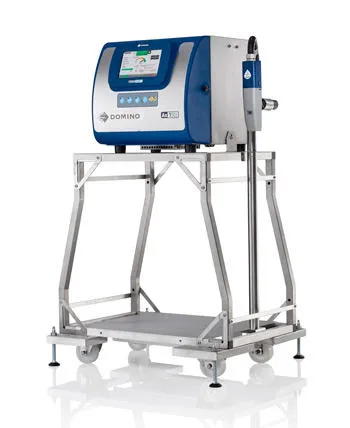The supporting infrastructure you’ll need for your coding and marking technology depends on your production environment, infrastructure, as well as the type of printer selected. Whether you are purchasing continuous ink jet, thermal ink jet, laser or print and apply technologies, the correct supporting solution beyond the core printer will help you to avoid delays and downtime on the production line whilst ensuring your coding operations are efficient.
Here are five examples of items to consider prior to installation:
1. Brackets
To code effectively, you need to make sure the print head is positioned in exactly the right place. That doesn’t just happen automatically. Bracketry can be ordered that ensures your print head is held securely when coding to ensure accuracy. However you may also require flexibility - you need to consider ordering a bracket that can be manoeuvred when necessary. For example, this is required if and when you change the products you are coding.

2. Stand
A stand can ensure your coding equipment is ideally placed and within proximity of the product you are marking. If your printer has a touchscreen, a stand will make it easier for your production staff to programme coding operations, providing an ergonomic solution. Alternatively, you may need to find substitutes for a stand. For example, as you may wish to stack multiple printers on top of another to compensate for “real estate” or space constraints.

3. Print-go mechanism
Ever wondered how a printer knows when to, well, print? Every printer requires a signal that tells it when to fire - whether that’s releasing a drop of ink or firing a laser. Using sensors allows a printer to anticipate products moving down a production line and instruct the correct moment to code the item in question. The type of sensor you need will depend on the substrates you typically code onto.
Retro-reflex sensors work by emitting a beam of light onto a prismatic reflector. If the beam is interrupted, the sensor tells the printer to print. Diffuse proximity sensors meanwhile operate by directing a light beam towards the object to be detected. The printer is told to print if the light is reflected.
There are a range of different types of sensors - including retro reflex sensors for transparent items, which detect the minute signal difference that reflected light undergoes when passing through transparent objects such as see-through plastic containers. You can also connect your printer to a host machine - such as a bottle filler or flexible packaging machine - so that the machines work in tandem.
Which sensor is best for you? That depends on the nuances of your production line and the items you are marking.
4. Encoder
Are all of your production lines consistently running at the same speeds? Maybe, but it’s unlikely. Variances in the speed you run your line can cause printers to produce poor quality codes. Encoders tackle that problem by tracking production line speeds to ensure all items are coded correctly. Encoders also require mounting kits, wheels and couplings. Make sure you fully specify your project to account for the variables in your production.
5. Beacon and line stop

Your printer is a critical component of your production operations. It needs to be maintained, cared for and monitored if you want to achieve maximum OEE and uptime. A beacon is a warning system that alerts production staff if it detects any problems with production machinery - saving both time and money. Line stops can automatically stop the line if a problem is detected. Ultimately, a smaller investment in time and money for the appropriate solution yields longer term benefits - this includes savings for a manufacturer in terms of downtime, OEE or eliminating potential waste of incorrectly coded products or packaging.
Need support?
Finding the right supporting infrastructure, accessories and associated parts for your printer isn’t always straightforward. It depends on the nuances of your production line, the print technology you are working with and the products you are marking. If you would like support, we can help. We have the specialist knowledge to make sure your supporting infrastructure is appropriate for your printer, your production facilities and, ultimately, your profits..